Saint Bernard is a large and massive breed of dogs that has established itself as an ideal animal for both training and home keeping. A distinctive feature of these animals is their large and always sad eyes. We will tell about the features of this breed of dogs, the intricacies of its cultivation and the history of origin in this article.

Origin history
This breed of dogs first appeared many centuries ago in ancient Egypt, namely in Assyria. Already in the chronicles of that time there are references to large dogs with an extremely soft and patient character and huge friendly eyes. Then these animals were called mollusks, they are the ancestors of the St. Bernards, and the German Great Dane, and the Mastiffs.
St. Bernards themselves in the form of a separate breed were bred in the II century. High in the Alps, a monastery was created and named after the name of its founder - Bernard de Menton - San Bernard. It was this monk who brought various large-sized dogs to his shelter and, by crossing them, bred St. Bernards.
Both the guests of the monastery and its permanent residents, the monks, noted that these animals have a very good-natured disposition and great intuition.
Animals always felt a change in the weather, before the avalanche they began to behave uneasily and could always find people whom the weather caught on the way. Their good disposition, devotion to the owners and excellent learning ability allowed them to become both rescuers and guides in the alpine mountains and mountains of Sweden.

Since the beginning of the XVII century, the popularity of these dogs has increased to heaven. Then already experienced breeders began to engage in the development of this breed further and actively use it in the service of the state of different countries. Since the 19th century, it was St. Bernards who were considered the best rescue dogs.
In 1884, a separate selection book was created in Switzerland, and breeders of this breed began to worry about its purity. From then until today, St. Bernards are considered one of the largest and most popular breeds not only for specialized use, for example, in rescue services, but also for ordinary home breeding.

Description of the breed, weight and height
Saint Bernards are large dogs with a rich pedigree, and therefore their appearance describes in detail the special standard of thoroughbred dogs. The characteristic of an adult is as follows.
- The height of the animal at the withers should be 70 cm for males and 65 cm for St. Bernard girls. It is allowed to exceed the standard by 10-15 cm upwards.
If the dog is smaller, it is considered defective and cannot be classified as purebred.
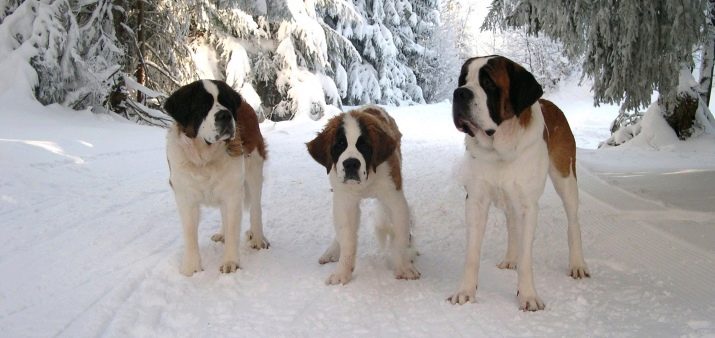
- The weight of the St. Bernards is also strictly regulated. Its minimum indicator is 60 kg, the maximum can reach 120 kg. It is important that there is a proportionality between the height of the St. Bernards at the withers and their body weight. If it is absent, then the dog is considered defective.
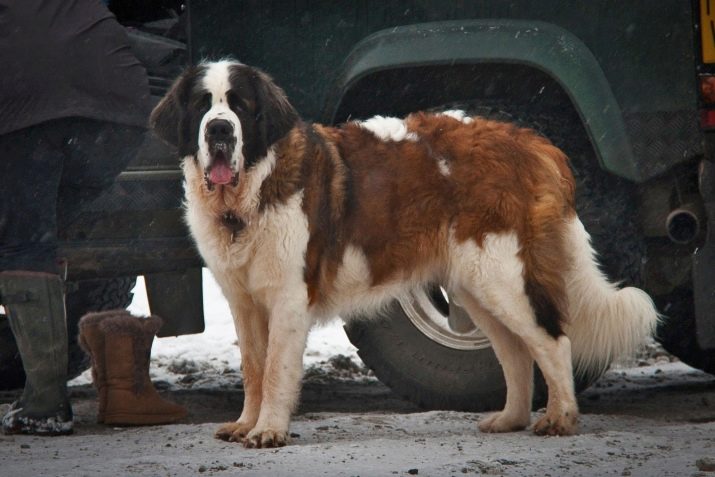
- The ideal body length of dogs is considered to be its ratio to the height at the withers in a ratio of 10: 9. At the same time, the withers itself rises significantly above the main line of the back.

- The skull of animals is wide, heavy. The superciliary arches and cheekbones are pronounced on it. There must be small skin folds under the eyes, and the lips are edged with a thin black stripe. The nose is always straight and wide, even, black.
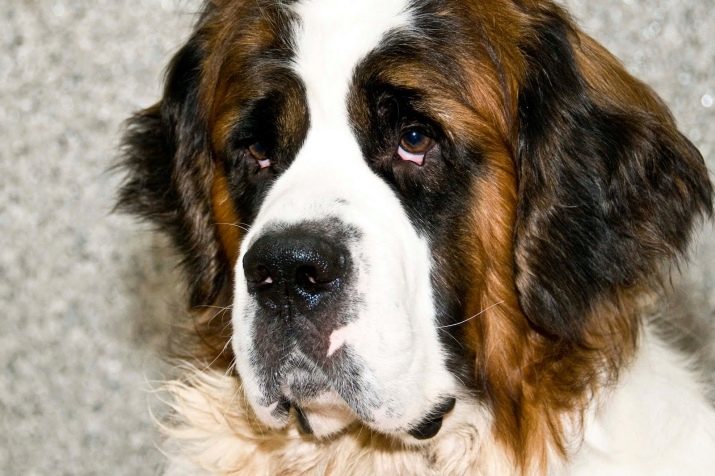
- The ears of St. Bernards are high and deep, have a triangular shape with rounded ends, slightly hanging on the forehead of the animal.
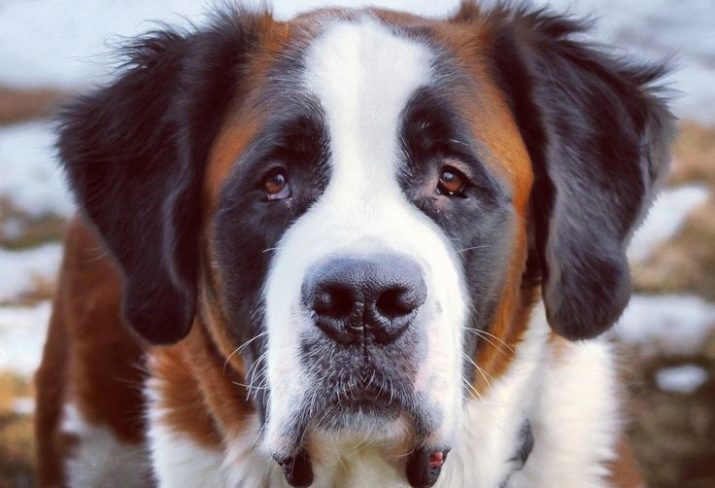
- The neck is wide, long and massive. The suspension is well defined on it.

- The jaw must be wide. The bite can be of two types: scissor-shaped or straight. Both species are considered valid and are not rock defects.

- The color of the eyes of dogs of this breed, more precisely, the color of their iris can be any intensity of brown color. If the eyes are blue, then the dog is not purebred.

- The tail of the St. Bernards is long, rather massive and heavy. Its base is strong and well visible from all sides. The hock joint and the last caudal vertebra are interconnected.

- Forelegs are straight, massive and widely spaced. The back is powerful, with pronounced muscles and fairly wide hips.
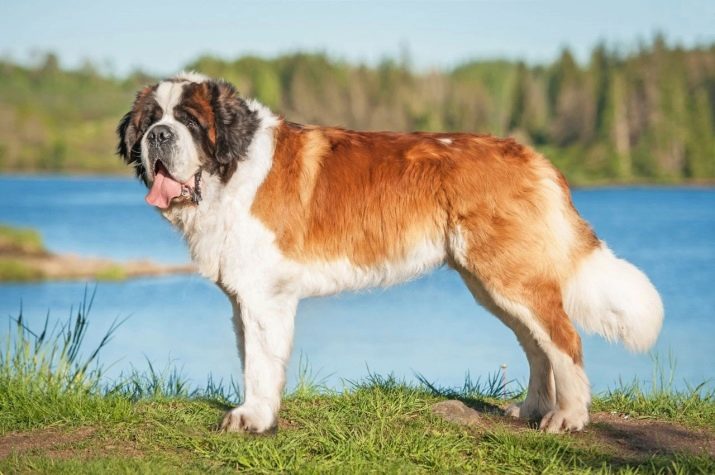
- The corpus of all St. Bernards is stately, well defined and massive. The back is wide and straight, and the chest is convex and massive, deep set.
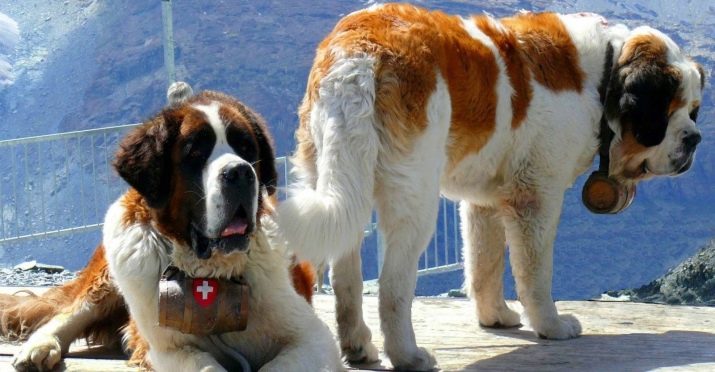
In addition, dogs of this breed are quite fertile. On average, there can be up to 13 puppies per litter. Puppies are born quite large, heavy and with good health.
Color options
The color of the coat of St. Bernards is also strictly regulated. The coat should be dyed white. On the cloak of the animal should be marked brown or golden. Instead of a spotted color, a raincoat is allowed - with it all the hair on the back and sides of the dog is painted in one color.

The presence on the body of the animal and dark spots - brown or even black. Today, dogs of this breed are often found, having a solid black color. Professional breeders and dog handlers consider such animals to be defective and insist that they cannot be considered purebred.

The fact is that in St. Bernards the main coat color is white. And a distinctive characteristic of the breed is the presence of mandatory white spots of wool on places of the body such as:
- tail tip;
- paws;
- forehead;
- chest;
- around the nose.
Only an animal with such white marks on the body is considered a full-fledged St. Bernard.
Character
Initially, this dog was bred as a search and rescue dog. And only an animal with a calm, balanced character can perform this type of work. And the St. Bernards are just that.
These animals get along well with humans and can be kept even in an apartment - St. Bernard will never create too much noise or fuss. The animal is smart, quickly learning all the commands and always executing them.
If there are children in the house, then a dog of this breed will become both a friend and a nanny for them. She will never grin and snarl at the child, but rather she just steps aside if she does not like something.

A distinctive feature of these animals is their hidden joy. Simple tail wagging at a meeting of people is an expression of stormy delight and pleasure.
As security guards, St. Bernards are not very reliable dogs, because they do not like, and some dogs do not know how to be aggressive.
In general, St. Bernards are friendly, reliable and companionable dogs. They will become the best friend to every person. But this is only subject to the proper education of the dog. If, from the moment of birth, the Saint Bernard is placed in isolated conditions and does not treat him as a full member of the family, then the dog can grow up to be the complete antipode of its characteristic - vicious, aggressive and not understanding any commands. So the nature of these animals largely depends on their upbringing and the conditions of rearing and keeping.

Life span
It is logical to assume that the large size of the animals of this breed and their massiveness, as well as a calm and balanced disposition are the key to the long life of the St. Bernards. In fact, this is not so at all.
Even under ideal conditions, these dogs do not live longer than 10-12 years. But if St. Bernard lives in severe weather conditions and often experiences strong physical exertion, then his life expectancy is reduced to 6-8 years.

Also, diseases such as:
- inversion of the eyelids, conjunctivitis and other eye diseases;
- gastritis, peptic ulcer, inversion of the intestines, that is, any problems in the digestive tract;
- osteoarthritis, joint dysplasia and other diseases of the musculoskeletal system.

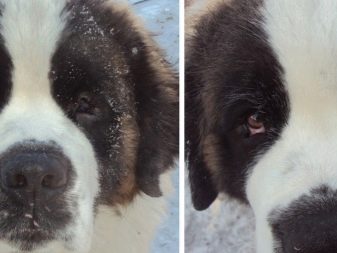
Saint Bernards most often suffer precisely from such diseases. That is why it is very important to provide them with the most comfortable living conditions, as well as regularly take the dog for examination to the veterinarian.
Only with proper and comprehensive care of the dog will she be able to live as long as possible and will feel good.
Varieties
Today, breeders and professional dog handlers distinguish only two main types of dogs of this breed.
- Shorthair St. Bernards have a fur close to the body, smooth and even. Often such animals are called smooth-haired St. Bernards.
- Longhair The dog got its name due to the length of the fur on its hind limbs and stomach. It is softer to the touch, longer and in some animals it seems to hang from the hips. Moreover, the fur is much shorter on the muzzle and lower limbs than on the rest of the body.
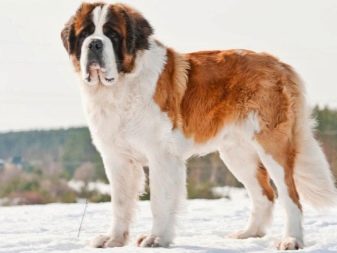
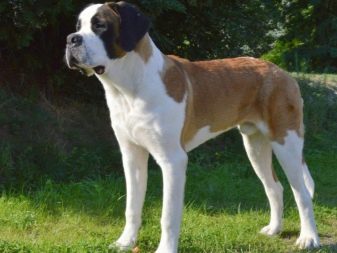
Both Shorthair Saint Bernard and Longhair have a very thick and warm undercoat, which protects them from hypothermia even in the most severe frosts.
How to choose a puppy?
In order to raise a really healthy, beautiful and intelligent friend, and it is very difficult to name St. Bernard in another way, you need to choose the right puppy. It will depend on how correctly the choice is made, whether an ordinary dog will be acquired or one that will subsequently be able to participate in various shows and competitions.
First of all, you should know that all dogs of this breed are divided into several main groups, depending on their further purpose:
- Pet class - the lowest discharge of the animal. St. Bernards belonging to this category are considered partially defective, therefore they are not entitled to participate in any exhibitions or shows. But they are perfect for home-style simple content and can become a person’s best friend.
- Show class - These are dogs of the highest category. Parents of such puppies have the best premium pedigree and they are best suited for professional breeders and dog handlers, as these dogs become the winners of various exhibitions and shows.
- Bridd class - These are high-level St. Bernards, but perhaps having some minor flaws. Such pets are suitable for participation in competitions and for simple maintenance at home.

If the choice is difficult to make, it is best to visit several nurseries and consult with professionals about the correct choice of pet.
It is important to remember that To buy a St. Bernard puppy for any purpose should only be with documents. If the animal does not even have a puppy passport, then it is best to refuse to acquire it. There is no guarantee that the dog in front of you is really a St. Bernard, and even a purebred.
The most correct decision in such a situation would be to purchase a puppy in a specialized nursery. This will not only give confidence in acquiring a purebred puppy, but also that he will be absolutely healthy and will already have all the necessary vaccinations.

But even when making a purchase in an elite nursery, it is necessary to remember some nuances.
- Anatomical features of the puppy must fully comply not only with the standards of its breed, but also with age and gender.
- Pedigree. In the kennels of each puppy, it must be mandatory. Let the pedigree be not too significant and significant, but it should be.
- Color animals should be exactly as described by the standard. Particular attention should be paid to the presence of classic white spots on the body of an animal. They are the clear evidence that the puppy is truly a purebred Saint Bernard.
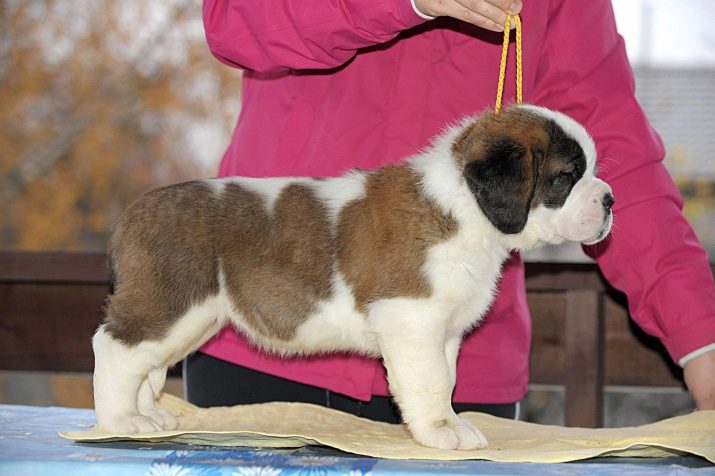
And it is very important to check the presence of the stigma on the puppy's body, its compliance with the breed, the nursery itself and the pedigree. It is also necessary to check the compliance of vaccinations with the vaccination calendar.
An important point is the cost of the puppy. The final price tag directly depends on the puppy’s pedigree, the significance of the kennel and the dog’s compliance with all standards. On average, the price of one St. Bernard puppy can not be lower than $ 250. The maximum price can reach 1000 dollars. But this is the cost in nurseries. For individuals, it can be several times lower.
Maintenance and care
In order for a dog of this breed to always look beautiful and well-groomed, and also feel good, it is necessary to properly care for it.
- Bathing puppies under the age of 6 months is strictly prohibited. Adult dogs are bathed only twice a year. The rest of the time, their body is simply wiped with a damp cloth.
- Particular attention is paid to the care of the eyes of St. Bernards. They are regularly cleaned of impurities, if necessary, the hair in this area is slightly shortened so that it does not get into the eyes. At the slightest sign of inflammation, the dog is sent to the veterinarian.
- Hair care is the main point. Every day the dog is combed out with a special brush, in which the teeth have a rounded shape. When the animal sheds - in the off-season, a brush with even thicker teeth is taken for combing. Combing the dog is necessary twice a day.
- If the animal was very dirty during the walk, then after combing it with a brush, the dog’s hair is wiped with a damp cloth, as well as its paws.
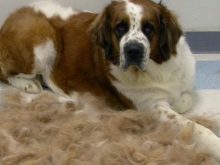
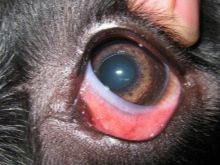
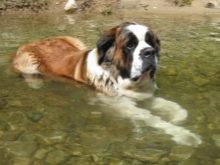
If we talk about the immediate conditions of detention, then they should be as follows.
- In an apartment or a private house, the animal must have its own personal corner.It is desirable that the place was not a walk-through, so that at least sometimes St. Bernard could just sleep peacefully and be alone.
- If the dog is kept in the yard, then it needs a spacious and comfortable booth. It is best if the St. Bernard does not sit on a chain, but walk freely in the yard, or at least in the aviary.
It is necessary to clean at the place of detention of St. Bernard daily. Not only the dog’s hair and waste products are removed, but also the litter is changed, and the dog’s bowls are washed every day. Such care measures help protect the dog from various diseases, in particular, from problems in working with the digestive tract.
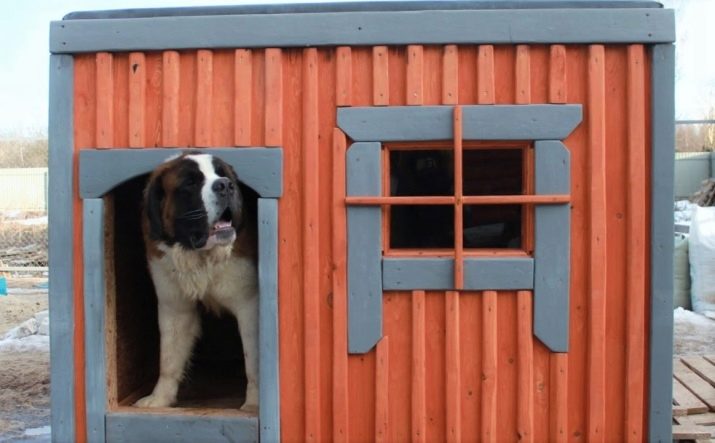
What to feed?
The proper diet of a dog of this breed, like many others, is a fundamental factor in its healthy growth, development, well-being and excellent appearance.
However, it is important to remember that in St. Bernards the gastrointestinal tract is one of the most vulnerable places.
Bringing a puppy home, it’s important to remember a few basic rules right away.
- For at least the first month, the dog’s menu should be exactly the same as the breeder’s. That is, it is forbidden to change the brand of dry food or replace natural nutrition with mixed.
- Feeding is carried out at the same time of day. First, dogs are fed 3-5 times a day, and as they grow older they are transferred to food twice a day.
- A dog can only get food from his bowl. The main task of the owner at the initial stages of education is to teach the dog that it is strictly forbidden to take food from the ground, floor or from someone else's dishes. The exception is a small piece of the delicacy that it can get from the owner’s hands during training.

Now about what is best to feed the animal. Professional breeders and dog handlers do not recommend using a mixed type of food. Saint Bernards are already quite prone to obesity. In addition, the simultaneous receipt by the dog of natural food and dry food can cause problems in the digestive tract and cause gastritis.
The easiest and best food option for dogs of this breed is dry finished food. But when making a choice, it is important to remember that it should not contain such ingredients as barley, soy and corn, as well as various enhancers of taste and smell. The presence of salt is extremely undesirable in the composition.
The following are considered to be one of the best brands of dry food for feeding St. Bernards:
- Belcando Adult Dinner;
- Guabi Adult Large and Giant Breeds;
- Acana Large Breed;
- Eukanuba Adult Large.




It is important to remember that if a pet has some kind of chronic disease, then the feed should be healing.
The same rule applies to food for sterilized or neutered animals - it must be specifically designed for dogs of this species.
Additional enrichment of such a diet with pure protein products is allowed. For example, in addition to the finished food, a dog can, and in some situations also need to be given raw meat, fish or offal. In such cases, the recommended amount of finished food is reduced by the weight equal to a portion of natural protein products. However, before applying such an enriched type of nutrition in practice, it is necessary to obtain specialist advice.
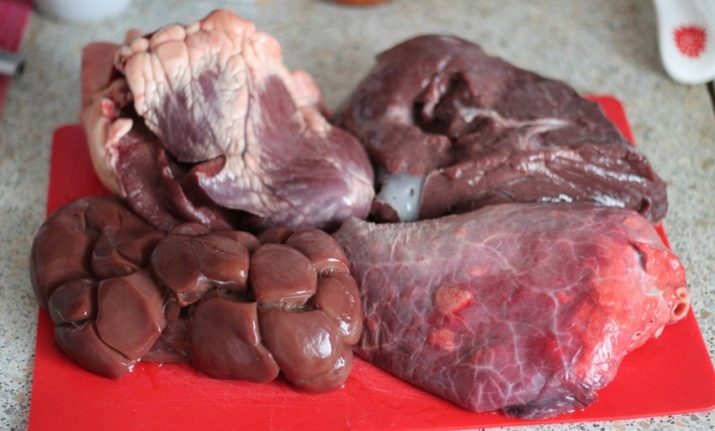
Fierce debate is still ongoing regarding the appropriateness of all-natural nutrition. Most professional breeders and veterinarians are inclined to believe that it’s entirely possible to feed St. Bernards with natural, home-cooked food at home. but only subject to a number of requirements.
- Mandatory enrichment of the diet with special vitamin and mineral supplements. Here you can use both ready-made pharmaceutical preparations and add individual vitamins, bone meal or fish oil to the feed.
- Basically, nutrition should consist of protein foods, most of which should be presented in the form of raw meat, fish and offal. They should occupy up to 75% of the total daily amount of food of the animal.
- From cereals, unpolished rice and buckwheat can be used.

Meat for St. Bernards is suitable only in raw form. It can be of almost any kind, but without excess fat. Fish, especially river fish, are included in the diet only in processed form.
As soon as the puppy is 6 months old, sour-milk products with a high content of calcium are included in his menu without fail. Vegetables are produced in small quantities and in boiled form.
It is also quite acceptable, and in some situations it is even necessary to enrich the pet’s diet with seafood. They contain special enzymes that help the dog's digestive system work properly. But the appropriateness of their use, as well as the type of feed and the frequency of inclusion in the menu should be determined only by the veterinarian.
Proper natural nutrition for St. Bernard to create at home is very difficult and costly. Therefore, if the owner of the puppy is not sure that he will be able to cope with this task correctly, it is best to immediately switch to the use of ready-made feed.

Parenting and training
St. Bernard training must be mandatory. An ill-bred dog carries a huge threat, and especially for itself.
When raising this animal, it is strictly unacceptable to use physical punishment and a loud cry. Up to a year a dog can be trained and raised by its owner. Only after the puppy is 12 months old it can be included in group training and training sessions for teams.
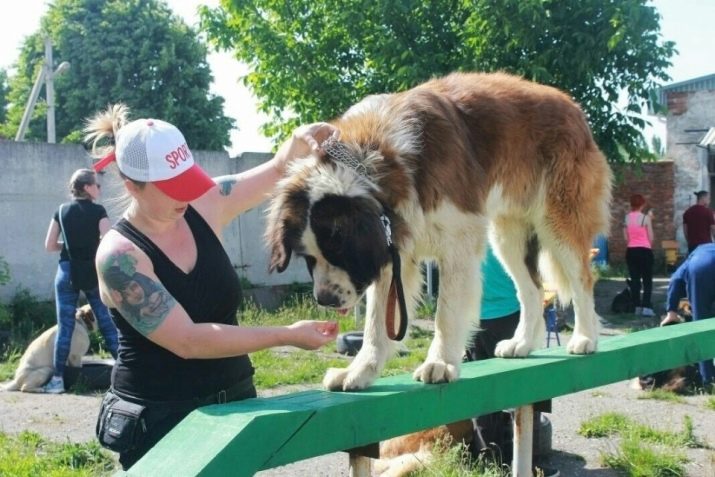
The fact is that dogs of this breed are very touchy, and, despite the impressive size, they mentally mature later than other large dogs. Therefore, up to a year, St. Bernard is considered a puppy.
Training a dog begins with teaching it to the simplest teams. The puppy must remember his name and always react correctly to him when the owner calls him. On a walk, he should not break out, play with a leash or collar.
It is very important to teach a little St. Bernard that picking up food on the street or taking it from the hands of strangers is strictly prohibited. The animal must master all these skills for up to 6 months. It is also important to teach the pet to wear a muzzle during this period. The animal should not break out and try to remove it.
At the age of 6 to 12 months, the owner of the St. Bernard can and must independently teach him to execute such commands as “Fu”, “Lie”, “Sit”, “Place”, “Aport”. Further more complex and professional training should be carried out only by professional dog handlers in training group courses.
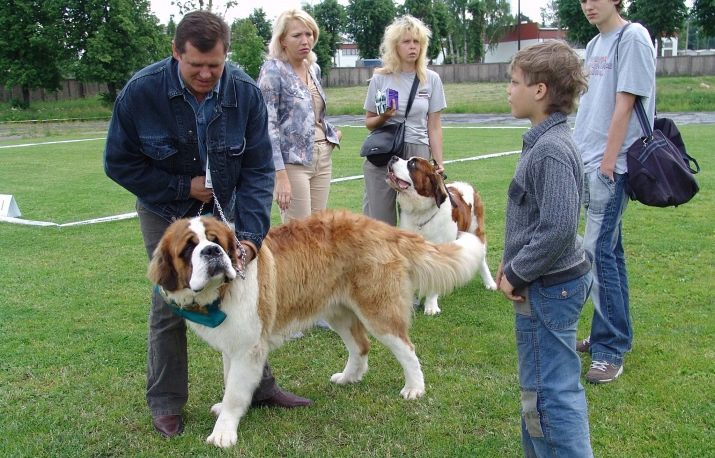
Difference from Moscow Watchdog
Despite the outward similarity of these two dog breeds, there are enormous differences between them, which you must be aware of.
Saint Bernards are considered one of the oldest breeds of dogs and for the first time they were listed in the canine book in the 19th century. The Moscow guard dog appeared much later and exclusively by artificial selection. The recognition of this breed officially happened only in the middle of the twentieth century.
In addition, the Moscow watchdog has less weight (up to 80 kg) and a lower height at the withers - up to 68 cm. Unlike St. Bernards, this breed of dog has all 4 limbs muscular, the tail has a saber shape, the body is more elongated, and the head is not so large and massive. The coat of a Moscow guard dog is always longer and thicker than that of St. Bernard.

Saint Bernard is a descendant of Mossols, while the Moscow watchdog is a hybrid of two different breeds, one of which is a Caucasian shepherd. Therefore, their character is very different. Often MS is a kind of antipode of St. Bernards.
These dogs are quite hot-tempered, unbalanced and able to show aggression.
Another significant difference is the content of dogs of these breeds. If a St. Bernard can be kept even in an apartment with young children, then the Moscow watchdog is best kept on the street, and until the dog undergoes a special training course, not to allow her close contact with children.
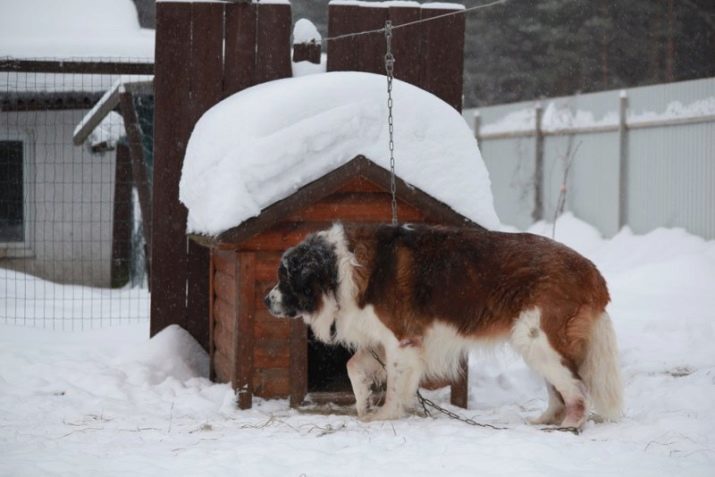
Owner reviews
Despite the high cost of puppies and difficulties with maintaining the dog itself, its owners leave positive feedback on representatives of this breed. The hosts emphasize the good-natured character of the St. Bernards, their easy learning. For many, a big plus is the coziness of pets with young children and other pets, as well as the possibility of their comfortable keeping even in an apartment.
The only disadvantage of this breed, according to its owners, is the high cost of the puppies, but the disadvantage is fully paid for by the advantages of the St. Bernards themselves and their unique appearance with a deep piercing gaze.

Look at the features of the St. Bernard breed in the video below.








































